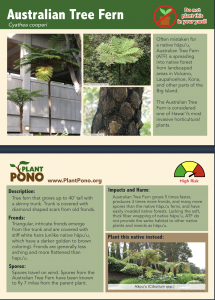Family: Cyatheaceae
An ornamental tree fern that quickly escaped cultivation to invade Hawaiian rainforests. Sphaeropteris cooperi is outcompeting the native hapu’u in almost every way. Australian tree fern grows five times faster, produced three times more fronds, has up to eight times more fertile fronds, and produces many more spores. Australian tree fern does not facilitate native seedling regeneration. Unlike the native hapu’u, which is a perfect nurse log for native plants.
Unfortunately, Australian tree fern is still in cultivation. Since 2003 naturalization records have occurred on all the main islands except Moloka’i. The Division of Forestry and Wildlife of the Hawaiʻi Department of Land and Natural Resources has designated this species as one of “Hawaiʻi’s Most Invasive Horticultural Plants.” Australian tree fern is a ‘no grow’ species for the Big Island Invasive Species Committee (BIISC) Plant Pono program.
Description and Dispersal:
- Large tree fern up to 40 ft tall with large (up to 18 ft long) triangular leaves made of lacy blades
- The silhouette resembles a martini glass while the native hapuu is more arching with fronds cascading down
- Scaly, brown stems fall off when dead, leaving persistent oval scars
- White hairs on stalks (unlike native hapu'u, which has red, black or brown hairs)
- Trunk does not have the thick, soft fiber wrapping like the native hapu'u, instead it is hard to touch
- Wind spreads spores can travel over 7 miles from the parent plant
High Risk Traits:
- Thrives in tropical climates
- Elevation range exceeds 1000 m
- Naturalized in the Hawaiian Islands, New Zealand, parts of Australia outside its native range, and possibly elsewhere
- An environmental weed (threatens biodiversity)
- Unpalatable to feral pigs (giving it a competitive advantage over Hawaiian tree ferns in the genus Cibotium)
- Alternate host of the Australian fern weevil, a pest of native ferns
- Small spines on scales can be a skin and eye irritant
- Shade-tolerant
- Tolerates many soil types
- Can from dense monocultures that exclude other vegetation
- Produces 1000s of wind-dispersed and water-dispersed spores
- Prolific spore production may result in inadvertent dispersal through soil contamination or through attachment to animals, clothing, or machinery
- Rapid growth rate and can reach maturity after 1 year
- Can regrow if cut down without damage to the apical meristem
Low Risk Traits:
- Not known to spread vegetatively
- Valued as an ornamental
- Herbicides have provided effective control





